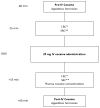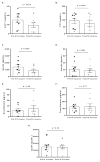Acute effects of intravenous cocaine administration on serum concentrations of ghrelin, amylin, glucagon-like peptide-1, insulin, leptin and peptide YY and relationships with cardiorespiratory and subjective responses - PubMed (original) (raw)
Acute effects of intravenous cocaine administration on serum concentrations of ghrelin, amylin, glucagon-like peptide-1, insulin, leptin and peptide YY and relationships with cardiorespiratory and subjective responses
Sofia Bouhlal et al. Drug Alcohol Depend. 2017.
Abstract
Background: Food intake and use of drugs of abuse like cocaine share common central and peripheral physiological pathways. Appetitive hormones play a major role in regulating food intake; however, little is known about the effects of acute cocaine administration on the blood concentrations of these hormones in cocaine users.
Methods: We evaluated serum concentrations of six appetitive hormones: ghrelin (total and acyl-ghrelin), amylin, glucagon-like peptide-1 (GLP-1), insulin, leptin and peptide YY (PYY), as well as acute cardiorespiratory and subjective responses of 8 experienced cocaine users who received 25mg intravenous (IV) cocaine.
Results: Serum concentrations of GLP-1 (p=0.014) and PYY (p=0.036) were significantly decreased one hour following IV cocaine administration; there was a trend towards a decrease for insulin (p=0.055) and amylin (p=0.063) concentrations, while no significant IV cocaine effect was observed for ghrelin (total or acyl-ghrelin) or leptin concentrations (p's≫>0.5). We also observed associations between hormone concentrations acutely affected by IV cocaine (GLP-1, PYY, insulin, amylin) and some cocaine-related cardiorespiratory and subjective responses (e.g., increased heart and respiratory rates; feeling high and anxious).
Discussion: These findings show a significant effect of acute IV cocaine administration on some appetitive hormones and suggest potential associations between these hormones and cocaine-related cardiorespiratory and subjective responses. Additional research is needed to further investigate the potential mechanisms underlining these associations.
Trial registration: ClinicalTrials.gov NCT01851473.
Keywords: Appetitive hormones; Cardiorespiratory responses; IV cocaine administration; Subjective responses.
Published by Elsevier B.V.
Conflict of interest statement
Conflict of interest
The authors report no conflicting biomedical financial interests.
Figures
Fig. 1. Schematic of study assessments, blood collections for hormone measurements, subjective responses to cocaine (SRC) and cardiorespiratory responses to cocaine (CRC)
*CRC: Cardiorespiratory responses to cocaine include systolic and diastolic blood pressure, heart rate, and respiratory rate. **SRC: Subjective Responses to Cocaine include “Crave Cocaine”, “Want Cocaine”, “Like Cocaine”, “Strong Drug Effect”, “Good Drug Effect”, “Bad Drug Effect”, “High”, “Rush”, “Elated”, “Stimulated”, “Suspicious”, “Anxious” and “Tired” assessed with 100 mm visual-analogue scales.
Fig. 2. Differences in appetitive hormone concentrations pre- and post-intravenous (IV) cocaine administration
IV cocaine administration significantly decreased (A) GLP-1 (p = 0.014) and (B) PYY (p = 0.036) concentrations, induced a tendency for decrease for (C) Insulin (p = 0.055) and (D) Amylin (p = 0.063), but had no effect on (E) Acyl-Ghrelin (p = 0.48), (F) Total Ghrelin (p = 0.73), or (G) Leptin concentrations (p = 0.62). Data are presented as mean and standard error of the mean (SEM).
Similar articles
- Incretins, amylin and other gut-brain axis hormones in children with coeliac disease.
Papastamataki M, Papassotiriou I, Bartzeliotou A, Vazeou A, Roma E, Chrousos GP, Kanaka-Gantenbein C. Papastamataki M, et al. Eur J Clin Invest. 2014 Jan;44(1):74-82. doi: 10.1111/eci.12193. Epub 2013 Nov 14. Eur J Clin Invest. 2014. PMID: 24151959 - Exploring the Role of Metabolic Hormones in Amyotrophic Lateral Sclerosis.
Moțățăianu A, Mănescu IB, Șerban G, Bărcuțean L, Ion V, Bălașa R, Andone S. Moțățăianu A, et al. Int J Mol Sci. 2024 May 7;25(10):5059. doi: 10.3390/ijms25105059. Int J Mol Sci. 2024. PMID: 38791099 Free PMC article. - The effect of meal frequency in a reduced-energy regimen on the gastrointestinal and appetite hormones in patients with type 2 diabetes: A randomised crossover study.
Belinova L, Kahleova H, Malinska H, Topolcan O, Windrichova J, Oliyarnyk O, Kazdova L, Hill M, Pelikanova T. Belinova L, et al. PLoS One. 2017 Apr 3;12(4):e0174820. doi: 10.1371/journal.pone.0174820. eCollection 2017. PLoS One. 2017. PMID: 28369078 Free PMC article. Clinical Trial. - Acute exercise and hormones related to appetite regulation: a meta-analysis.
Schubert MM, Sabapathy S, Leveritt M, Desbrow B. Schubert MM, et al. Sports Med. 2014 Mar;44(3):387-403. doi: 10.1007/s40279-013-0120-3. Sports Med. 2014. PMID: 24174308 Review. - Effects of exercise intensity on plasma concentrations of appetite-regulating hormones: Potential mechanisms.
Hazell TJ, Islam H, Townsend LK, Schmale MS, Copeland JL. Hazell TJ, et al. Appetite. 2016 Mar 1;98:80-8. doi: 10.1016/j.appet.2015.12.016. Epub 2015 Dec 22. Appetite. 2016. PMID: 26721721 Review.
Cited by
- An Overview of Appetite-Regulatory Peptides in Addiction Processes; From Bench to Bed Side.
Shevchouk OT, Tufvesson-Alm M, Jerlhag E. Shevchouk OT, et al. Front Neurosci. 2021 Dec 9;15:774050. doi: 10.3389/fnins.2021.774050. eCollection 2021. Front Neurosci. 2021. PMID: 34955726 Free PMC article. - An amylin analogue attenuates alcohol-related behaviours in various animal models of alcohol use disorder.
Kalafateli AL, Vallöf D, Colombo G, Lorrai I, Maccioni P, Jerlhag E. Kalafateli AL, et al. Neuropsychopharmacology. 2019 May;44(6):1093-1102. doi: 10.1038/s41386-019-0323-x. Epub 2019 Jan 23. Neuropsychopharmacology. 2019. PMID: 30710109 Free PMC article. - Salmon Calcitonin Attenuates Some Behavioural Responses to Nicotine in Male Mice.
Aranäs C, Vestlund J, Witley S, Edvardsson CE, Kalafateli AL, Jerlhag E. Aranäs C, et al. Front Pharmacol. 2021 Jun 21;12:685631. doi: 10.3389/fphar.2021.685631. eCollection 2021. Front Pharmacol. 2021. PMID: 34234676 Free PMC article. - Can GLP-1 Be a Target for Reward System Related Disorders? A Qualitative Synthesis and Systematic Review Analysis of Studies on Palatable Food, Drugs of Abuse, and Alcohol.
Eren-Yazicioglu CY, Yigit A, Dogruoz RE, Yapici-Eser H. Eren-Yazicioglu CY, et al. Front Behav Neurosci. 2021 Jan 18;14:614884. doi: 10.3389/fnbeh.2020.614884. eCollection 2020. Front Behav Neurosci. 2021. PMID: 33536884 Free PMC article. - Leptin Protects Against the Development and Expression of Cocaine Addiction-Like Behavior in Heterogeneous Stock Rats.
Carrette LLG, Corral C, Boomhower B, Brennan M, Crook C, Ortez C, Shankar K, Simpson S, Maturin L, Solberg Woods LC, Palmer AA, de Guglielmo G, George O. Carrette LLG, et al. Front Behav Neurosci. 2022 Mar 3;16:832899. doi: 10.3389/fnbeh.2022.832899. eCollection 2022. Front Behav Neurosci. 2022. PMID: 35316955 Free PMC article.
References
- Abizaid A, Mineur Y, Roth R, Elsworth J, Sleeman M, Picciotto M, Horvath T. Reduced locomotor responses to cocaine in ghrelin-deficient mice. Neuroscience. 2011;192:500–506. - PubMed
- Beal DJ. SAS® code to select the best multiple linear regression model for multivariate data using information criteria. Paper presented at: Southeast SAS Users Group Conference; Portsmouth, VA. 23–25 Oct. 2005; 2005. Paper SA01_05.
- Beal SL. Ways to fit a PK model with some data below the quantification limit. J Pharmacokinet Pharmacodyn. 2001;28:481–504. - PubMed
MeSH terms
Substances
LinkOut - more resources
Full Text Sources
Other Literature Sources
Medical

